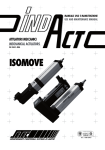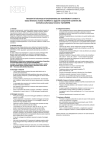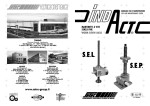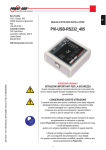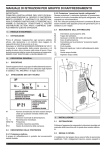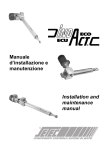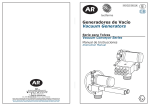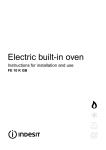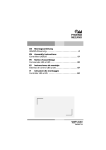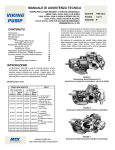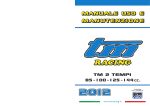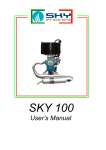Download ISOMOVE ISOMOVE
Transcript
MANUALE USO E MANUTENZIONE USE AND MAINTENANCE MANUAL ATTUATORI MECCANICI MECHANICAL ACTUATORS ISO 15552 : 2004 ISOMOVE Cert. n° EMS-2240/S 1 www.setec-group.it Manuale uso e manutenzione ISOMOVE ISOMOVE use and maintenance ISOMOVE MODULO BASE - ISOMOVE BASIC MODULE Versione con chiocciola flangiata Flanged nut release Tappo a tassello mobile per ingrassaggio Sliding plug for lubrication Versione con chiocciola filettata Threaded hreaded nut release Tappo filettato per ingrassaggio Screw plug for lubrication Versione antirotazione in materiale plastico Antirotation rod in plastic material release P/N Fig. 1 1 2 3 4 5 6 7 8 9 9B 10 11 12 13 14 15 16 16 17 18 PZ Pcs 1 1 1 1 1 1 1 1 1 8 1 1 1 1 2 1 1 1 1 19 20 1 1 DESCRIZIONE DESCRIPTION TESTATA ANTERIORE TESTATA POSTERIORE CAMICIA ISOMOVE ATTACCO FILETTATO STELO VITONE ROTELLA PISTONE ASTA ANTIROTAZIONE VITI VITE TCCE CUSCINETTO GHIERA AUTOBLOCCANTE FASCIA DI GUIDA MERKEL ANELLO MAGNETICO GRANO UNI 5923 CHIOCCIOLA TIPO FILETTATO CHIOCCIOLA TIPO FLANGIATO VITE 097F TAPPO TCEI TASSELLO SCORREVOLE BOCCOLA RASCHIATORE FRONT HEAD REAR HEAD CYLINDER SCREW CAP EXTENSION ROD BALLSCREW ROLLER PISTON ANTIROTATION ROD SCREWS SCREW TCCE BEARING SELF-LOCKING NUT GUIDING LINER MERKEL MAGNETIC RING GRUB SCREW THREADED NUT FLANGED NUT SCREW 0.97 F SCREW PLUG SLIDING BOSS BUSHING SCRAPER Antirotazione in bronzo Bronze antirotation rod 2 www.setec-group.it ISOMOVE VERSIONE “D” / ISOMOVE “D” VERSION P / N PZ DESCRIZIONE Pcs 00 21 22 23 24 25 26 27 1 1 1 4 1 4 1 1 28 1 28B 29 1 1 ISOMOVE BASE DISTANZIALE FLANGIA MOTORE VITE TSEI MOTORE VITE TCEI GIUNTO SERVO FLANGIA BLOCCAGGIO CUSCINETTO TAPPO TCEI TASSELLO SCORREVOLE VITE TAPPO A PRESSIONE DESCRIPTION ISOMOVE BASIC MODULE SPACER MOTOR FLANGE TSEI SCREW MOTOR TCEI SCREW COUPLING BEARING COUPLING FLANGE SCREW PLUG SLIDING BOSS SCREW CAP Tappo filettato per bloccaggio giunto Thread stopper for coupling locking screw Fig. 2 Versione con tappo a tassello mobile per bloccaggio giunto Sliding plug for servo-coupling locking screw ISOMOVE VERSIONE “R” / ISOMOVE “R” VERSION P / N PZ Pcs 00 1 21 1 22 1 23 1 24 1 25 1 26 4 27 4 28 2 29 1 30 4 31 4 32 6 33 1 34 1 35 2 36 8 DESCRIZIONE DESCRIPTION ISOMOVE BASE FLANGIA MOTORE CARTER PULEGGIA VITE CALETTATORE CINGHIA DENTATA VITE TCEI VITE TCEI VITE TCEI MOTORE VITE TCEI ROSETTA DI SICUREZZA ROSETTA DI SICUREZZA CALETTATORE PULEGGIA PANNELLO LATERALE VITE TSEI ISOMOVE BASIC MODULE MOTOR FLANGE CASING SCREW PULLEY SHRINK DISC TOOTHED BELT SCREW TCEI SCREW TCEI SCREW TCEI MOTOR SCREW TCEI WASHER WASHER SHRINK DISC PULLEY SIDE PANEL SCREW TSEI Fig. 3 3 www.setec-group.it Manuale uso e manutenzione ISOMOVE / ISOMOVE use and maintenance IDENTIFICAZIONE ACTUATOR DESIGNATION Su ogni prodotto è applicata una targhetta identificativa che riporta i principali dati che lo caratterizzano: In every product there is a plate with all the main info about the product you have purchased: w w w. s e t e c - g r o u p . i t - T. + 3 9 . 0 11 . 4 5 1 8 6 11 Code N° I M – 0 5 0 – 0 5 – 0 0 5 0 – R – S 4 8 Drw N° I – 0 0 5 0 – 0 0 0 0 – 0 0 0 – 0 0 5 0 Order N° X X X X X X X Serial N° X X X X X X Fig. 4 CODE: IM (ISOMOVE) – O5O (TIPO) – 05 (PASSO VITE) – 0050 (CORSA) – R (POSIZIONE MOTORE ➝ R = RINVIATO, D = DIRETTO) – S48 (TIPO MOTORE). Fig. 4 CODE: IM (ISOMOVE) – O5O (SIZE) – 05 (SCREW LEAD) – 0050 (STROKE) – R (MOTOR POSITION ➝ R = BELT GEAR VERSION, D = IN LINE VERSION) – S48 (MOTOR TYPE) In caso di assistenza siete pregati di annotare ciascun dato in modo da identificare il prodotto in oggetto. If you need assistance, you are pleased to send us every data to let us identify the product. 4.1.0 TIPOLOGIA DI IMPIEGO 4.1.0 OPERATING ENVIRONMENT 4.1.1 Temperatura di lavoro: - 20°C; +70°C 4.1.2 Grado di protezione IP: tutti gli attuatori standard sono realizzati con grado di protezione IP54 a condizione che il motore elettrico raggiunga tale grado di protezione. 4.1.3 Intermittenza di lavoro: tutti gli attuatori standard garantiscono le prestazioni nominali indicate nel nostro catalogo in assenza di urti e di vibrazioni, con carichi esclusivamente di tipo assiale e una temperatura ambiente di 40°C. Per condizioni differenti contattare il nostro servizio tecnico. 4.1.4 NORMATIVE Tutti i prodotti SETEC sono costruiti in accordo alla normativa CEE sulle macchine. come componenti di macchine i nostri attuatori possono essere installati solo su macchinari con caratteristiche rispondenti alla normativa comunitaria sulle macchine secondo le seguenti: EN 292-1, EN 2.1991, EN 954-1, EN 294.1992, EN 349.1993, EN 418.1992 In caso di installazione dei nostri prodotti su macchinari che non seguono le normative di legge, la SETEC non garantisce su possibili danni arrecati agli attuatori o per l’incolumità degli operatori. 4.2.0 INSTALLAZIONE 4.1.1 Operating temperature: - 20°C; +70°C 4.1.2 IP rating: all standard actuators are made in IP54 rating in agreement as the standard electric motors. 4.1.3 Duty cicle: all standard actuators guarantee the nominal performance indicated in our catalogue, in absence of impacts and vibrations, with purely axial forces and an environment temperature of 40°C. Contact our technical service for different conditions. 4.1.4 COMMUNITARY RULES All SETEC products are realized according to CEE rules about machines; as machine elements, our actuators can be used only inside machines in accordance with the followings CEE rules: EN 292-1, EN 2.1991, EN 954-1, EN 294.1992, EN 349.1993, EN 418.1992 If our actuators are used inside equipments not according the rules above, SETEC doesn’t garantee for possible damages or the safety of the operators. 4.2.0 INSTALLATION N.B. PRIMA DI RENDERE OPERATIVA LA MACCHINA OCCORRE LEGGERE ATTENTAMENTE IL SEGUENTE MANUALE E SEGUIRNE LE INDICAZIONI RIPORTATE; TENERE LA SEGUENTE PUBBLICAZIONE E TUTTI I DOCUMENTI A CUI SI FA RIFERIMENTO IN LUOGO ACCESSIBILE A CIASCUN OPERATORE E AL PERSONALE DI MANUTENZIONE. LA SETEC SI RISERVA IL DIRITTO DI NON PROVVEDERE ALLA RIPARAZIONE O ALLA SOSTITUZIONE IN BEFORE STARTING THE MACHINERY, USERS MUST READ THE FOLLOWING MAUAL; KEEP THIS AND ALL THE RELATED DOCUMENTS IN AN A PLACE ACCESSIBLE TO THE MAINTENANCE STAFF. SETEC COULD ASSERT THE RIGHT NOT TO REPAIR OR TO REPLACE UNDER WARRANTY WHEN DAMAGES ARE DUE TO UNCORRECT USE OF THE ACTUATORS OR WRONG MAINTENANCE. 4 www.setec-group.it GARANZIA DEI NOSTRI PRODOTTI IN CASO DI DANNI DOVUTI A UN NON CORRETTO UTILIZZO DELL’ATTUATORE E/O A UNA ERRATA MANUTENZIONE. Per qualunque altra informazione vi rimandiamo alla consultazione del catalogo SETEC specifico che rappresenta parte integrante dello stesso. 4.3.0 STARTING CHECKS 4.3.0 CONTROLLI PRECAUZIONALI ALL’AVVIO 4.3.1 Tutti i nostri prodotti sono accuratamente controllati prima della 4.3.2 4.3.3 4.3.4 4.3.5 4.3.6 4.3.7 4.3.8 4.3.9 4.3.10 For any other information, consult the specific catalogue SETEC “ISOMOVE” that is an integral part of this manual. spedizione, tuttavia si richiede a scopo precauzionale di verificare possibili impedimenti al movimento degli organi interni o il serraggio delle viti delle testate. Accertarsi che la struttura su cui è montato l’attuatore sia in grado di sopportare il carico massimo previsto senza subire delle deformazioni che comprometterebbero il funzionamento dell’elettrocilindro. N.B. I nostri attuatori sono progettati per movimentare carichi nella sola componente assiale e un carico radiale, seppur di piccola entità, o un carico disassato potrebbero compromettere l’affidabilità e la durata utile del gruppo vite a ricircolo-chiocciola. Provvedere alla pulizia dell’attuatore e nello specifico dello stelo per evitare che impurità possano penetrare all’interno del sistema, utilizzando prodotti idonei che non intacchino i trattamenti superficiali dei materiali. (I nostri attuatori prevedono l’utilizzo di un raschiapolvere che, a seconda della grandezza, può essere interno o esterno). Polvere e abrasivi potrebbero accelerare l’usura degli organi in movimento. I nostri attuatori sono forniti di tappi filettati (Fig.1-18) o, a seconda del modello, tasselli mobili impiegati per tappare il foro ricavato sulla camicia del cilindro da utilizzare per la lubrificazione. Verificare il corretto serraggio per impedire la fuoriuscita di grasso lubrificante o l’ingresso di impurità nel sistema. È i nd i s pen sab ile a l fin e d i sal vag u ar d ar e l a d u r at a dell’elettrocilindro evitare qualsiasi urto e/o forti vibrazioni al sistema; è infatti risaputo che le viti a ricircolo di sfere e gli stessi cuscinetti subiscono forti stress meccanici in caso di urto soprattutto a cilindro fermo. Evitare di superare i limiti di carico nominale dichiarato per evitare gravi danni al sistema, durate fortemente ridotte e deformazioni permanenti che pregiudicherebbero la funzionalità dell’attuatore. A tal scopo è buona norma, in caso di utilizzo di motori brushless, prevedere un controllo sui picchi di coppia (fino a 5 volte il valore nominale) tipiche di questo tipo di motorizzazione. Superare i limiti di coppia nominale in ingresso all’attuatore potrebbe determinare gravi danni al sistema e pregiudicarne la vita utile. Non portare mai l’attuatore a battuta meccanica! In caso di applicazioni in cui la traslazione è lungo l’asse verticale occorre prevedere un sistema frenante che mantenga fermo il carico quando il motore è spento. Il sistema vite a ricircolo- chiocciola è infatti un sistema reversibile dote intrinseca dovuta alla bassissima condizione di attrito interno. Negli elettocilindri con motorizzazione rinviata la trasmissione del moto avviene mediante cinghia dentata senza gioco in poliuretano con rinforzi in acciaio per impedirne l’allungamento. Il tensionamento della cinghia è predeterminato da un interasse fisso tra le pulegge per cui non è previsto alcun tipo di tenditore. Qualora sia indispensabile provvedere alla sostituzione della cinghia in caso di gioco eccessivo, vi rimandiamo alla lettura del 4.3.1 All SETEC products are carefully tested before delivery; for precautionary measure, it’s important to verify that the object rotates freely and the correct locking of screws of the two heads of the actuator. 4.3.2 Ensure that the structure the actuator is mounted on is sufficiently strong to stand the maximum load without having any deformation which could affect the good operation of the actuator. 4.3.3 Our actuators are realized to stand only axial forces; radial or not aligned forces could compromise the proper operation and the reliability of the product and reduce is the its lifetime. 4.3.4 Clean the actuator and the extension rod to avoid that impurity may enter, using the right products not to corrode the surface of the materials. (Our actuators have inside, or outside according to the dimension, a scraper ring). Dust and abrasives may accelerate the wear of inner components. 4.3.5 Our actuators are supplied with screw plugs (Fig.1-18) or sliding boss (depending on the model) to plug the hole used for the lubrication of the ballscrew. Verify the correct tightening to avoid the grease to go out or impurity to go in. 4.3.6 To safeguard the life time of the actuator it’s very important to keep off any impact and vibration; it’s well-known that ball screws and bearings are strongly stressed by impacts particularly when the actuator is motionless. 4.3.7 Never exceed the limits of the nominal load stated in order to avoid serious damage to the system, strongly reduced life time and permanent deformations that could compromise the proper operation of the actuator. According to what has been written above, when a brushless motor is used, you must limit torque peaks. 4.3.8 Never use the actuator inner parts as mechanical shoulder! 4.3.9 When the actuator is used in application in which the load is moved along the vertical axis it’s necessary to provide the actuator with a brake that stops the load when the motor is off; it’s due to the reversibility of the ballscrew. 4.3.10 In belt gear actuators, it’s used a V-belt zero backlash polyurethane steel reinforced belt to avoid its elongation. The tension of the belt is stated by a fixed pulleys’ wheelbase, so no tensioning system is there. If it’s necessary to change the belt when backlash due to wear is there; in this case we ask you to read the following pages related to assembling and disassembling operations. 4.3.11 “Antirotation device” is used to let the extension rod move without rotation, when there’s no external guiding. To avoid the rotation of the inner group (nut - piston - extension rod) that would forbid the ballscrew to transform the rotary movement in a linear one, it’s available the antirotation device. It’s clear that, as a consequence, the antirotation device is designed to stand very low torques so it mustn’t be used to stand external torques. When the translation of the load generates torques along the movement’s axis it’s good that external systems could be able to neutralize them to avoid the deformation of the extension rod that would compromise the proper operation of the actuator. 5 www.setec-group.it Manuale uso e manutenzione ISOMOVE / ISOMOVE use and maintenance capitolo specifico sul montaggio e smontaggio dell’attuatore. 4.3.11 Il sistema opzionale “antirotazione” è utilizzato per permettere la fuoriuscita dello stelo anche in quelle condizioni di assenza di contrasto esterno. Al fine proprio di evitare la rotazione dell’intero gruppo mobile (chiocciola-pistone-stelo), che impedirebbe la trasformazione del moto mediante il sistema a vite da rotatorio a traslatorio, viene utilizzata l’antirotazione. Si evince come la coppia che deve sopportare sia di bassissima entità per cui non può essere in nessun modo utilizzata per vincere delle coppie esterne anche lievi. Nei casi in cui, per effetto della traslazione del carico, possano generarsi delle coppie lungo l’asse del moto è indispensabile che vengano neutralizzate da sistemi esterni all’attuatore per evitare deformazioni dell’asta antirotazione che pregiudicherebbero il corretto funzionamento dell’attuatore. (Per le tipologie di antirotazione disponibili Vi rimandiamo alla descrizione generale del sistema). 4.3.12 Non ruotare mai lo stelo nelle versioni in cui è presente il sistema antirotazione per non danneggiare l’attuatore. 4.4.0 MONTAGGIO DEL MOTORE NELLA VERSIONE “R” RINVIATA (Fig. 3) 4.4.1 4.4.2 4.4.3 4.4.4 4.4.5 4.4.6 4.4.7 4.4.8 4.4.9 Svitare le viti (28). Togliere il carter (22). Posizionare e avvitare il motore (29) tramite le viti (30). Calzare la cinghia (25) sulle pulegge (23) (34) con inseriti i calettatori (24) e (33). Inserire contemporaneamente la puleggia (23) sull’albero del motore e la puleggia (34) sull’estremità della vite a ricircolo (06) [Fig. 1]. Bloccare i calettatori (24) e (35) secondo la tabella “C” relativa ai calettatori (per la tipologia del calettatore verificare le dimensioni). Controllare il perfetto parallelismo e allineamento delle pulegge. Riposizionare il carter (22). Inserire e bloccare le viti (28). 4.5.0 MONTAGGIO DEL MOTORE NELLA VERSIONE “D” DIRETTA (Fig. 2) 4.5.1 Posizionare il giunto (26) sull’alberino del motore (24) verificando 4.5.2 4.5.3 4.5.4 4.5.5 che la posizione assiale del giunto, una volta accoppiato al motore ed inserito nella campana (22), sia tale da permettere il raggiungimento della apposita vite di bloccaggio del giunto stesso tramite il foro ricavato sul distanziale (21). Sfilare il motore (24) e serrare il giunto (26) sull’albero del motore agendo sulla vite apposita, rispettando le coppie di serraggio riportate nella tabella “D”. (Per la tipologia del giunto, verificare la sigla riportata sul giunto stesso). Posizionare il motore (24) completo di giunto (26) sulla campana (22) e bloccare il medesimo con le viti (25). Bloccare il giunto (26) sulla vite a ricircolo (06) [Fig. 1] ,facendo riferimento alla tabella “D”, mediante il foro presente sul distanziale (21). Tappare il foro sul distanziale (21) mediante il tappo (28) che, a seconda del modello, potrà essere filettato o a tassello mobile. (For types of antirotation device you are asked to see the general description of the actuator). 4.3.12 Never rotate the extension rod when the antirotation device is there not to damage the actuator! 4.4.0 MOUNTING MOTORS IN BELT GEAR VERSION “R” (Fig. 3) 4.4.1 4.4.2 4.4.3 4.4.4 4.4.5 4.4.6 4.4.7 4.4.8 4.4.9 Unscrew screws (28). Remove casing (22). Put in position the motor and screw it (29) using screws (30). Set the belt (25) on pulleys (23) (34) with sleeves inside (24) and (33). Insert at the same time the pulley (23) on motor shaft and the pulley (34) on the back of the ballscrew (06) [Fig. 1]. Lock the shrink disc (24) and (35) according to the Tab “C” about shrink disc (check sleeves’ type seeing the identification plate). Check the perfect alignment and parallelism of pulleys’ axis. Position the casing (22). Insert and block screws (28). 4.5.0 MOUNTING MOTORS IN LINE VERSION “D” (Fig. 2) 4.5.1 Put in position the servo coupling (26) on motor shaft (24) 4.5.2 4.5.3 4.5.4 4.5.5 verifying that axial servo coupling position, once joined to the motor and inserted in the flange (22), permits to reach the locking screw of the servo coupling through the hole in spacer (21). Pull out the motor (24) and tighten the servo coupling’s screw (26) on motor’s shaft, according to the Tab “D”. (Check servo coupling’s type seeing identification plate). Position motor (24) with servo coupling in (26), on flange (22) and lock it with screws (25). Grip servo coupling (26) to the ballscrew (06) [Fig. 1], according to the Tab “D”, through the hole in spacer (21). Plug the hole in spacer (21) using the screw plug (28) that, on the base of the model, would be made as a sliding boss too. 4.6.0 ORDINARY MAINTENANCE AND SCHEDULED CONTROLS 4.6.1 A suitable maintenance with a correct use avoids problems in terms of reliability and safety, furthermore it guarantees functionality and quality through the product life; so we ask you to have a scrupulous care of scheduled maintenance in the summarizing tab below (Tab. “A”). 4.6.0 MANUTENZIONE ORDINARIA E CONTROLLI PERIODICII 4.6.1 Una buona manutenzione del sistema, insieme ad un corretto utilizzo, evitano problemi legati all’affidabilità e alla sicurezza garantendone funzionalità e qualità nel tempo, per cui vi chiediamo di seguire scrupolosamente gli interventi di manutenzione programmata riassunti nella tabella di seguito (Tab. “A”): 6 www.setec-group.it INTERVALLO FREQUENCY PARTICOLARE PART Dopo 2 MESI dall'installazione 2 months after installation VITI TESTATE Entro 6 mesi HEAD SCREWS Within 6 months INTERVENTO TYPE CHECK CONTROLLO SERRAGGIO TIGHTEN SCREWS Rif. Ref. montaggio - manuale d'uso mounting - use guide 500 ore / hours VITE A RICIRCOLO LUBRIFICAZIONE / LUBRICATION Manutenzione - manuale d'uso / Maintenance - use guide BALLSCREWS GIOCO CHIOCCIOLA / NUT BACKLASH Catalogo VITI a sfere SETEC / SETEC ballscrew catalogue 12-18 MESI Every 12-18 MONTHS GIUNTO / SERVO COUPLING CONTROLLO SERRAGGIO / TIGHTEN SCREWS Montaggio - manuale d'uso / Mounting - use guide 12 / 18 MESI Every 12 / 18 MONTHS CALETTATORI / SHRINK DISCS CONTROLLO SERRAGGIO / TIGHTEN SCREWS Montaggio - manuale d'uso / Mounting - use guide 12 / 18 MESI Every 12 / 18 MONTHS CINGHIA DENTATAI / V BELT CONTROLLO GIOCO / CHECK BACKLASH Manutenzione - manuale d'uso / Maintenance - use guide 12 / 18 MESI Every 12 / 18 MONTHS PULEGGIA / PULLEY VERIFICA ALLINEAMENTO / CHECK ALIGNMENT Controlli all'avvio - manuale d'uso / Starting check - use guide * In condizioni di carico e di utilizzo gravosi dimezzare gli intervalli di manutenzione dichiarati. * In heavy load and use condition double the frequency of planned maintenance. Tab. “ A” Tab. “A” 4.6.2 CONTROLLO SERRAGGIO: 4.6.2 SCREW TIGHTENING CHECK: 4.6.2.1 VITI DI FISSAGGIO TESTATE: verificare il serraggio delle viti 4.6.2.1 HEAD SCREWS:verify screw tightening using the specific tool; mediante bussola specifica; in caso di condizioni gravose e con forti vibrazioni intensificarne il controllo (per le coppie di serraggio vedere Tab. “B”); 4.6.2.2 GHIERA AUTOBLOCCANTE: la ghiera per il blocco del cuscinetto ha il compito di vincolare assialmente la vite. L’insorgenza di gioco, dovuto a condizioni anomale di funzionamento, potrebbe pregiudicare la durata del cuscinetto e la precisione di posizionamento dell’attuatore. Per l’accesso alla ghiera vi rimandiamo al capitolo “montaggio e smontaggio”. 4.6.2.3 GIUNTO DI TRASMISSIONE: il giunto ha il compito di trasmettere il moto in caso di motorizzazione “D” diretta tra l’albero motore e la vite a ricircolo. I giunti utilizzati sono del tipo a gioco zero e adottano un collegamento a morsetto. Per evitare slittamenti che pregiudicherebbero la precisione di posizionamento dell’attuatore occorre verificare periodicamente il serraggio utilizzando chiavi dinamometriche (le coppie sono riportate nella tabella “D”). Per la tipologia di giunto vedere la sigla riportata sul giunto stesso. Per l’accesso al giunto vi rimandiamo al capitolo “montaggio e smontaggio“. 4.6.2.4 CALETTATORE: il calettatore ha il compito di bloccare le pulegge sul relativo albero, assicurarsi quindi che lo stesso sia sempre ben bloccato. Le coppie di serraggio sono riportate nella Tab. “C”. Per la tipologia di calettatore vedere le dimensioni dello stesso. Per l’accesso ai calettatori vi rimandiamo al capitolo “montaggio e smontaggio”. 4.6.2.5 Gli attuatori vengono forniti con sistema di bloccaggio dei filetti delle viti di serraggio (Loctite morbida); nel caso di acquisto di attuatori in versione custom, per consentire il montaggio del motore, alcune viti non vengono bloccate. in heavy load applications, or in presence of vibrations, intensify the control (see Tab. “B”). 4.6.2.2 SELFLOCKING NUT: the selflocking nut has the task to axially constrain the ballscrew. The birth of backlash, due to abnormal working conditions, could reduce the life time of bearings and the correct actuator’s positioning accuracy. To get to the self locking nut, see the “mounting and disassembling” chapter. 4.6.2.3 SERVO COUPLING: the servo coupling is used to transmit the power, in “D” ISOMOVE version, between motor shaft and ballscrew. The coupling is “zero” backlash type; to avoid sleepery condition that could create a bad positioning, it’s important to check the tightening of its locking screw through a dynamometric key (see Tab “D” for tightening torque). Check servo coupling’s type seeing identification plate. To get to the servo coupling, see the “mounting and disassembling” chapter. 4.6.2.4 SHRINK DISC: it has the task to lock the pulley on relative shaft, be sure that it is always locked (see Tab “C” for tightening torque). Check servo coupling’s type seeing identification plate. To get to the servo coupling, see the “mounting and disassembling” chapter. 4.6.2.5 In our actuators all the screws are blocked using the “LOCTITE” thread locking system; when a custom actuator is bought, to allow motor installation some screws aren’t locked. Once the motor mounted, we suggest you to apply the LOCTITE system. 7 www.setec-group.it Manuale uso e manutenzione ISOMOVE / ISOMOVE use and maintenance Si consiglia, una volta effettuato il montaggio, di applicare della Loctite morbida. Più in generale di seguito vengono allegate le tabelle relative alle norme sul serraggio; la seguente norma stabilisce i valori della coppia nominale e relative tolleranze da applicare per il serraggio della bulloneria in funzione delle applicazioni. Per la scelta delle classi di serraggio, consultare la Tab.B1 e definire il bullone da utilizzare, riportato in Tab.B2, considerando le forze di trazione di ogni singolo bullone (Tab. B3). In the tabs below you can find the values of tightening torque of the screws according to the Community rules; the following rule sets torque and tolerance values to apply for tightening screws on the base of applications. To choose the tightening class, consult Tab. B1 and define the screw to use, seeing Tab B2, according to the strength of every screw (Tab B3) Classe di serraggio Tightening class Applicazioni Applications Tolleranze riferite alla coppia funzionale Tolerances according to nominal torque I MOLTO IMPEGNATIVE VERY HEAVY ±5% II IMPEGNATIVE HEAVY 5% -15% III POCO IMPEGNATIVE NOT HEAVY 5% -35% Tab. “B1” Filettatura THREAD Apertura chiave della vite e/o del dado Screw’s tool 7 8 10 13 17 19 22 24 27 30 32 36 41 46 M4 M5 M6 M8 M10 M12 M14 M16 TABELLA B! B” B£M18 M20 M22 M24 M27 M30 7 8 10 13 17 19 22 24 27 30 32 36 41 46 [ N] [ Nm] M4 M5 M6 M8 M10 M12 M14 M16 M18 M20 M22 M24 M27 M30 CLASSE DI SERRAGGIO / TIGHTENING CLASS III II I CLASSE DI RESISTENZA DELLA VITE / SCREW STRENGHT CLASS 8,8 10,9 12,9 CLASSE DI RESISTENZA DEL DADO / NUT STRENGHT CLASS 8 10 12 2,3 4,8 8 20 39,2 68,8 108 168 232 328 440 568 840 1160 3,3 6,8 11,2 28 55,2 96 152 236 324 464 624 800 1200 1600 3120 4360 5080 7160 7200 10080 13200 18560 20960 29520 b3 30640 TABELLA b1 b2 43200 42000 59200 58400 81600 70400 99200 91200 128000 112800 159200 131200 184000 172000 241600 209600 294400 4 8 13,6 32,8 66,4 116 184 284 388 552 744 960 1440 1920 5240 8560 12080 22320 35440 51600 70800 98400 118400 153600 191200 220800 290400 253600 Tab. “B2” Coppia di serraggio Tightening torque Tab. “B3” Forza di trazione Axial strenght 8 www.setec-group.it 4.6.3 CONTROLLO GIOCHI 4.6.3 BACKLASH CHECK 4.6.3.1 CUSCINETTO: il cuscinetto impiegato è del tipo a gioco ”zero” 4.6.3.1 BEARINGS: the bearings used in our actuators are angular a doppio contatto obliquo, tuttavia in condizioni di funzionamento gravose è opportuno verificare il gioco assiale per non avere errori di posizionamento dell’attuatore e una rapida usura del componente. Qualora si siano verificati dei giochi procedere alla sostituzione del cuscinetto stesso. Per l’accesso al cuscinetto vi rimandiamo al capitolo “ montaggio e smontaggio “ . 4.6.3.2 CINGHIA DENTATA: non è prevista la possibilità di regolare il tensionamento della cinghia; se in condizioni particolari dovesse verificarsi un allungamento della cinghia provvedere alla sostituzione. Per l’accesso alla cinghia vi rimandiamo al capitolo “montaggio e smontaggio”. 4.6.3.3 VITE A RICIRCOLO / CHIOCCIOLA: la chiocciola viene fornita sempre con gioco assiale il cui valore è dichiarato nel catalogo SETEC (viti a ricircolo di sfere). Qualora in condizioni particolari il gioco assiale dovesse superare il valore massimo nominale occorre sostituire il sistema vite/chiocciola per non incorrere in errori di posizionamento. contact double rows “zero” backlash type; in heavy working condition it’s important to control the axial backlash to avoid positioning errors of the actuator and a quick wear of the component. To get to the bearing , see the “mounting and disassembling” chapter. 4.6.3.2 V-BELT: it’s not available a tensioning system; change the belt if its length should abnormally increase. To the access to the v-belt , see the “ mounting and disassembling “ chapter. 4.6.3.3 BALLSCREW / NUT: the standard nut is with axial backlash; you can find the value of the backlash in the SETEC ballscrew catalogue. If, in particular working condition, the backlash should exceed the maximum nominal value it is necessary to replace the ballscrew not to have positioning errors. 4.6.4 LUBRIFICAZIONE 4.6.4.1 L’attuatore viene fornito con la vite a ricircolo completamente lubrificata; essendo il sistema totalmente sigillato, la fase di lubrificazione può avvenire ad intervalli piuttosto ampi (vedi par. 4.6 Tab. “A” ), tuttavia una periodica lubrificazione contribuisce a limitare la rumorosità, ridurre le coppie d’attrito e quindi il calore generato. I lubrificanti impiegabili sono i medesimi utilizzati per la lubrificazione dei cuscinetti. 4.6.4.2 La lubrificazione è del tipo manuale e può avvenire introducendo direttamente un ugello all’interno della camicia dell’attuatore ed erogando il lubrificante direttamente sulla vite; per questa operazione occorre far riferimento alla seguente procedura (vedi Fig. 5 per schema di lubrificazione): 4.6.4.2.1 far fuoriuscire lo stelo (05) fino a fondo corsa in modo da aver libero accesso alla vite (06). 4.6.4.2.2 svitare il tappo (18) o la vite del tassello mobile laddove previsto. 4.6.4.2.3 introdurre l’ugello attraverso il foro sulla camicia (03) dell’attuatore fino a raggiungere la vite (06). 4.6.4.3 Evitare di introdurre quantità eccessive di grasso per non pregiudicare il corretto funzionamento dell’attuatore. 4.6.4 LUBRICATION 4.6.4.1 Before delivering, the ballscrew of the actuator is completely lubricated; as it is totally sealed, the lubrication can be made with a low frequency (see Par.6 Tab. “A”), however a recurring lubrication may reduce noise, friction torques and then heat generation. 4.6.4.2 The lubrication can be realized by hand introducing the nozzle into the cylinder and distributing the grease directly on screw; to do that, see the following procedure (see Fig. 5 below): 4.6.4.2.1 the extension rod (05) up to stroke end (06). 4.6.4.2.2 unscrew plug (18) or the screw of the sliding boss where provided. 4.6.4.2.3 introduce the nozzle through the hole in the cylinder (03) to reach the ballscrew (06). 4.6.4.3 In order not to damage the actuator, do not put in a quantity of grease bigger than the required value. SCHEMA DI LUBRIFICAZIONE ISOMOVE / ISOMOVE LUBRIFICATION CHART Foro su camicia Hole in cylinder Passaggio attraverso foro per lubrificazione diretta della vite Way to lubrificate directly the ballscrew Stelo in posizione estesa Extension rod in external position FIGURA / FIGURE 5 Chiocciola Nut Vite a ricircolo Ballscrew 9 www.setec-group.it Manuale uso e manutenzione ISOMOVE / ISOMOVE use and maintenance 4.6.4.4 L’intervallo di lubrificazione può essere mediamente pari a 500 ore di funzionamento; questa prescrizione è soltanto indicativa e può variare in funzione del tipo di applicazione. Per un approfondimento si rimanda a consultare il catalogo viti a ricircolo SETEC. 4.6.5 VERIFICA USURA 4.6.5.1 BOCCOLA ANTIFRIZIONE: lo stelo (05 - Fig.1) è vincolato radialmente in quanto guidato da una boccola (19 - Fig. 1) in materiale a basso attrito. Qualora si verificasse un gioco radiale controllare il corretto impiego dell’atuatore e, se necessario, sostituire la boccola stessa. Per l’accesso alla boccola vi rimandiamo al capitolo “montaggio e smontaggio“. FASCIA DI GUIDA MERKEL: trattasi di fascia in materiale polimerico impiegata sul pistone come antifrizione nel contatto con la camicia. In condizioni di corretto impiego dell’attuatore non si deve verificare un consumo della fascia di guida pertanto verificare sempre il montaggio dell’elettrocilindro in caso di insorgenza di gioco radiale dello stelo e quindi del pistone. 4.6.5.2 4.6.4.4 The frequency of lubrication is 500 working hours; this is an indicative instruction and it could change on the base of the application. See also SETEC “ BALLSCREW “ catalogue to have more info. 4.6.5 WEAR CHECK 4.6.5.1 BUSHING: the extension rod (05 - Fig.1) is radially constrained because leaded by an antifriction bushing (19 - Fig. 1). Should a radial backlash arise, control that the actuator is cor rectly used and, if necessary, replace the bushing. To get to the bushing, see the “ mounting and disassembling “ chapter. INNER LINER MERKEL: it’s a ring in polymeric material used on the piston as antifriction guiding system into the cylinder. In a correct use of the actuator the ring will not wear out; should this happen, verify that the actuator is correctly mounted in the machinery. 4.6.5.2 4.7.0 EXTRAORDINARY MAINTENANCE 4.7.1 In all cases in which, during the ordinary maintenance, it’s need to disassemble the actuator, read the followings pages. 4.7.2 DISASSEMBLING 4.7.2.1 4.7.2.1.1 4.7.2.1.2 4.7.2.1.3 4.7.2.1.4 ISOMOVE BASIC MODULE (Fig. 1): Unscrew with specific tool screws (10) of the HEADS (01 -02). Remove the HEAD (01) from the EXTENSION ROD (05). Remove SCRAPER (20) and the BUSHING (19). Unscrew the SELF-LOCKING NUT (12) from the BALLSCREW (06). Remove the BEARING (11) through the hole of the HEAD (02) and from the BALLSCREW (06). Remove the HEAD (02) from the BALLSCREW (06). Remove the CYLINDER (03) from the EXTENSION ROD/PISTON/BALLSCREW group. Remove the ANTIROTATION DEVICE (09) from the CYLINDER (03) [where available, unscrew screws (9B) to remove the antirotation device]. Unscrew the GRUB SCREWS (15) from the PISTON (08). Unscrew the EXTENSION ROD (05) from the PISTON (08). Unscrew the PISTON (08) from the NUT in threaded NUT release unscrew the screws from the flange of the NUT (16) in flanged NUT release. Remove INNER LINER MERKEL (13) and MAGNETIC RING (14) from PISTON (08). Move the NUT (16) near the end of BALLSCREW (06). 4.7.0 MANUTENZIONE STRAORDINARIA 4.7.1 In tutti i casi in cui durante la manutenzione ordinaria si renda necessario lo smontaggio dell’attuatore è opportuno leggere le seguenti indicazioni per il montaggio e lo smontaggio. 4.7.2 SMONTAGGIO 4.7.2.1 4.7.2.1.1 4.7.2.1.2 4.7.2.1.3 4.7.2.1.4 4.7.2.1.5 VERSIONE ISOMOVE BASE (Fig. 1): Svitare con apposita bussola le viti (10) delle TESTATE (01 - 02). Sfilare la TESTATA (01) dallo STELO (05). Estrarre il RASCHIAPOLVERE (20) e la BOCCOLA (19). Svitare la GHIERA (12) dal codolo della VITE (06). Sfilare il CUSCINETTO (11) dal foro della TESTATA (02) e dal codolo della VITE (06). Sfilare la TESTATA (02) rispetto al codolo posteriore della VITE (06). Sfilare la CAMICIA (03) dal gruppo STELO/PISTONE/VITE. Estrarre l’asta ANTIROTAZIONE (09) dalla CAMICIA (03) [laddove previsto occorre svitare le VITI (9B) per liberare l’ANTIROTAZIONE]. Svitare i grani (15) dal PISTONE (08). Svitare lo STELO (05) dal PISTONE (08). Svitare il PISTONE (08) dalla CHIOCCIOLA (16) nelle versioni a chiocciola filettata; rimuovere le viti di fissaggio della flangia della CHIOCCIOLA (16) nelle versioni a chiocciola flangiata. Rimuovere FASCIA MERKEL (13) e ANELLO MAGNETICO (14) dal PISTONE (08). Portare la CHIOCCIOLA (16) verso l’estremità della VITE (06). 4.7.2.1.6 4.7.2.1.7 4.7.2.1.8 4.7.2.1.9 4.7.2.1.10 4.7.2.1.11 4.7.2.1.12 4.7.2.1.13 4.7.2.1.5 4.7.2.1.6 4.7.2.1.7 4.7.2.1.8 4.7.2.1.9 4.7.2.1.10 4.7.2.1.11 4.7.2.1.12 4.7.2.1.13 N.B. Per non far fuoriuscire le sfere durante lo sfilamento della chiocciola è indispensabile interporre un tubo con diametro esterno pari al diametro corrispondente alle piste di rotazione delle sfere sulla vite e lunghezza superiore alla chiocciola. Per maggiori dettagli vi rimandiamo a consultare il catalogo SETEC viti a ricircolo. To avoid the exit of balls from the nut when you are unscrewing it from the ballscrew, it’s very important to interpose a tube with the external diameter equal to the balls’ liner of the ballscrew and a length greater then the nut’s one. For more info, consult SETEC “BALLSCREW” catalogue. 10 www.setec-group.it 4.7.2.2 VERSIONE CON MOTORIZZAZIONE DIRETTA (Fig. 2) 4.7.2.2 4.7.2.2.1 Rimuovere il TAPPO filettato (28) o le VITI (28B) del TASSELLO a SCORRIMENTO (28). DIRECT DRIVE PACKAGE ISOMOVE “D” RELEASE (Fig. 2) 4.7.2.2.1 Remove the SCREW PLUG (28) (or screws (28B) from the SLIDING BOSS PLUG (28). 4.7.2.2.2 Muovere lo STELO (05) per mettere in rotazione il GIUNTO 4.7.2.2.2 Move the EXTENSION ROD (05) to make the SERVO 4.7.2.2.7 (26) finchè la vite di serraggio del morsetto risulta accessibile passando attraverso il foro sul DISTANZIALE (21) (nelle versioni con TAPPO a PRESSIONE (29) il processo potrebbe non richiedere di movimentare lo stelo ). Svitare le VITI (25) e rimuovere il motore (24). Rimuovere il GIUNTO (26) dall’albero motore intervenendo sull’apposita vite del morsetto. Svitare le VITI (23) e sfilare la FLANGIA MOTORE (22) e il DISTANZIALE (21). Rimuovere il GIUNTO (26) dalla VITE A RICIRCOLO intervenendo sull’apposita vite del morsetto. Sfilare la FLANGIA BLOCCAGGIO CUSCINETTO (27). 4.7.2.2.7 COUPLING (26) rotate till its locking screw become accessible passing through the hole in SPACER (21) (in release with CAP (29) you needn’t move the extension rod). Unscrew SCREWS (25) and remove MOTOR (24). Remove SERVO COUPLING (26) from the motor’s shaft unscrewing its fixing screw. Unscrew the SCREWS (23) and remove MOTOR FLANGE (22) and SPACER (21). Remove SERVO COUPLING (26) from the BALLSCREW unscrewing its locking screw. Remove the BEARING COUPLING FLANGE (27). 4.7.2.3 VERSIONE CON MOTORIZZAZIONE RINVIATA (Fig. 3) 4.7.2.3 BELT GEAR PACKAGE ISOMOVE “R” RELEASE (Fig. 3) 4.7.2.2.3 4.7.2.2.4 4.7.2.2.5 4.7.2.2.6 4.7.2.3.1 Svitare le VITI (27 - 28) e rimuovere il CARTER (22) per 4.7.2.2.3 4.7.2.2.4 4.7.2.2.5 4.7.2.2.6 4.7.2.3.1 Unscrew SCREWS (27 - 28) and remove CASING (22) to accedere al gruppo di trasmissione rinviato. have access to the belt gear transmission group. 4.7.2.3.2 Allentare i CALETTATORI (33 - 24) intervenendo sulle apposite 4.7.2.3.2 Loosen SHRINK DISC (33 - 24) by its screws and take out viti ed estrarre la CINGHIA (25) e le PULEGGE (23 - 34). BELT (25) and PULLEYS (23 - 34). 4.7.2.3.3 Svitare le VITI (30). 4.7.2.3.4 Sfilare il MOTORE (29) 4.7.2.3.5 Svitare le VITI (26) ed estrarre il corpo ISOMOVE BASE (00). 4.7.3 4.7.2.3.3 Unscrew SCREWS (30). 4.7.2.3.4 Pull out the MOTOR (29). 4.7.2.3.5 Unscrew the SCREWS (26) and remove BASE ISOMOVE (00) group. MONTAGGIO ASSEMBLY 4.7.3.1 In via generale ripercorrendo a ritroso la procedura di smontaggio 4.7.3 delle relative versioni (vedere inoltre Par. 4 e 5) è possibile effettuare il montaggio, prestando una particolare cura all’assemblaggio delle seguenti parti: 4.7.3.1.2 VITE A RICIRCOLO / CHIOCCIOLA (entrambe le versioni, filettata e flangiata) In caso di sostituzione della chiocciola vi verrà fornito il componente su cui è presente un tubetto; non sfilare mai il tubetto, pena la fuoriuscita delle sfere! Il tubetto deve essere sfilato dalla chiocciola a mano a mano che la chiocciola si avvita sul filetto della vite a ricircolo. La sezione del tubetto deve appoggiare proprio sull’inizio del filetto della vite a ricircolo senza discontinuità; le sfere rotolano su un diametro approssimativamente pari al diametro esterno del tubetto, in questo modo le sfere possono essere trattenute dentro la sede della chiocciola fino a trovare l’inizio del filetto della vite. In caso di approfondimenti vi rimandiamo al catalogo ”viti a ricircolo” SETEC. 4.7.3.1.3 CINGHIA DENTATA Per evitare stress eccessivi ai cuscinetti degli alberi su cui sono calettate le pulegge e per evitare disallineamenti, in caso di sostituzione della cinghia, è bene allentare le viti dei CALETTATORI (24 - 33) al fine di ridurre il tensionamento da applicare alla cinghia. Stringendo i calettatori si ottiene automaticamente il tensionameto e il centraggio adeguato. In ultima analisi occorre sempre verificare l’allineamento della cinghia verificando che la stessa non si intraversi. 4.7.3.1.4 CALETTATORI E GIUNTI Al fine di garantire l’adeguata trasmissione del moto dall’albero motore alla vite è indispensabile che le viti dei giunti e dei calettatori vengano serrate secondo la corretta coppia di 4.7.3.1 Generally speaking if you follow disassembling procedure in the opposite sequence it’s possible to assemble the unit, taking good care of the following parts: 4.7.3.1.2 BALLSCREW (both threaded and flanged NUT release when you need to replace the nut, the new component will be sent with a tube inserted in; never extract the tube, the balls would fall down. The tube must be pulled out from the nut while it’s screwing on the screw; the tube must be laid at the starting thread of the screw without discontinuity; balls roll on a diameter equal to the external diameter of the tube, so that the balls can be retained inside the nut’s liners till they reach the thread of the ballscrew. For more info, consult SETEC “BALLSCREW” catalogue. 4.7.3.1.3 V-BELT To avoid stresses and misalignment of the shafts on which the pulleys are coupled, when you must replace the v-belt, it’s important to unscrew the locking screws of the SHRINK DISCS (24 - 33) to reduce belt tensioning. By locking the shrink discs you can obtain the right tension and centering at the same time. At the end, always verify the alignment of the belt checking it moves properly without veering. 4.7.3.1.4 SHRINK DISCS AND SERVO COUPLING To guarantee the right power transmission from the motor shaft to the ballscrew, shrink discs and servo coupling’s screws have to be locked according to the correct tightening torque (see Tab. “C” referred to sleeves’ torque and Tab. “D” referred to servo coupling’s torque). To check the shrink disc and servo coupling’s type see the identification plate. 11 www.setec-group.it Manuale uso e manutenzione ISOMOVE / ISOMOVE use and maintenance serraggio. (Vedere Tab. “C” per le coppie di serraggio dei calettatori e Tab. “D” per le coppie di serraggio dei giunti. Per il tipo di giunto e calettatore verificare la sigla riportata sugli stessi. VITI DI SERRAGGIO / LOCKING SCREWS DIN 912 mm 12,9 Coppia di serraggio Tightening torque dXD N° x tipo / type Nm 6 x 16 6,35 x 16 7 x 17 8 x 18 9 x 20 9,53 x 20 10 x 20 11 x 22 12 x 22 14 x 26 15 x 28 16 x 32 17 x 35 18 x 35 19 x 35 20 x 38 22 x 40 24 x 47 25 x 47 25,4 x 47 28 x 50 30 x 55 32 x 55 35 x 60 38 x 65 40 x 65 42 x 75 45 x 75 48 x 80 50 x 80 3 x M2,5 3 x M2,5 3 x M2,5 3 x M2,5 4 x M2,5 4 x M2,5 4 x M2,5 4 x M2,5 4 x M2,5 4 x M3 4 x M3 4 x M4 4 x M4 4 x M4 4 x M4 4 x M5 4 x M5 4 x M6 4 x M6 4 x M6 6 x M6 6 x M6 6 x M6 8 x M6 8 x M6 8 x M6 6 x M8 6 x M8 8 x M8 8 x M8 1,2 1,2 1,2 1,2 1,2 1,2 1,2 1,2 1,2 2,1 2,1 4,9 4,9 4,9 4,9 10 10 17 17 17 17 17 17 17 17 17 41 41 41 41 Tab. “C” Coppie Serraggio Calettatori / Shrink discs’ tightening torque Misurare il diametro interno di calettamento della puleggia e il diametro dell’albero; in base al dato ottenuto identificare il calettatore corrispondente e prendere nota della corretta coppia di serraggio nella colonna denominata “Coppia di serraggio”. Tipo / Type D1 mm D2 mm DIN 912 Coppia di serraggio Tightening torque Nm ADS 10 6 16 M4 5 ADS 18 10 24 M5 10 ADS 60 14 32 M6 18 ADS 150 16 38 M8 43 ADS 300 24 45 M 10 84 DKN 20/42 3 12,7 M3 1 It’s possible to identify the right shrink disc by measuring the inner pulley and screw diameter; on the base of these values you can find the tightening torque regarding the shrink disc choosen. Tab. “D” Coppie Serraggio Giunti / Coupling’s tightening torque Misurare i diametri dell’albero del motore e del codolo della vite; in base ai dati ottenuti identificare il giunto corrispondente e prendere nota della corretta coppia di serraggio nella colonna denominata “Torque to Tighten Clamps”. It’s possible to identify the right coupling by measuring the motor shaft and screw diameter; on the base of these values you can find the tightening torque regarding the coupling choosen. 12 www.setec-group.it Manuale uso e manutenzione ISOMOVE / ISOMOVE use and maintenance 4.8.0 FINECORSA MAGNETICI 4.8.0 LIMIT SWITCHES Tutti gli attuatori sono muniti di anelli magnatici (14 - Fig. 1) montati sul pistone (08 - Fig. 1). A richiesta possono essere forniti i finecorsa magnetici da alloggiare direttamente nelle cave dell’estruso con cui è realizzata la camicia (03 - Fig. 1). Insieme con i finecorsa magnetici verrà fornita la relativa documentazione a cui chiediamo di fare riferimento in caso di uso e manutenzione. 4.9.0 MOTORI ELETTRICI Every actuator is supplied with a magnetic ring (14 - Fig. 1) mounted on the piston (08 - Fig. 1); on request reed sensors are available, they can be housed directly in the slots of the aluminium extruded profile. 4.9.0 ELECTRIC MOTORS Our actuators can be supplied with motors; see par. 4 and 5 to see how to install the motor; you’ll receive the documentation, we ask you to refer to, for use and maintenance. Gli attuatori possono essere forniti completi di motorizzazione. Per il montaggio sull’attuatore vedere, in base alla tipologia, i paragrafi 4 e 5. Insieme con i motori verrà fornita la relativa documentazione a cui chiediamo di fare riferimento in caso di uso e manutenzione. 13 www.setec-group.it















